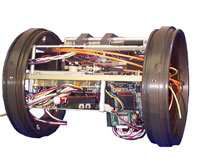You are here: Home › Stressors › Extreme Events › Harmful Algal Blooms › Feature Stories › BreveBusters Provide Automated, In-Water Detection of Florida Red Tide Conditions
BreveBusters Provide Automated, In-Water Detection of Florida Red Tide Conditions
Every two hours BreveBusters, deployed on fixed platforms in Charlotte Harbor and
BreveBusters, or red tide sensors, are part of a new system designed to monitor automatically for red tide and create an early-warning system. Image courtesy of G. Kirkpatrick.
off the coast of Sarasota,
record bloom conditions of the Florida red tide organism, Karenia brevis.
Karenia species possess a unique pigment that changes how light passes through water.
The in-water sensors, which can also be deployed in autonomous underwater vehicles (AUVs), detect Karenia blooms in real-time by comparing light passing through seawater with and without Karenia.
The data are automatically sent from the buoy to a shore based lab. Such early
detection and continuous monitoring of bloom events ultimately improves the
efficiency of event response and mitigation by coastal managers, as well as
enables industries and beachgoers to better prepare for bloom effects. Continuous,
real-time data will also enhance NOAAís integrated harmful algal bloom (HAB)
forecasting system in the region, especially as more BreveBusters are added
to the network. This network has already proven to be successful when integrated
with satellite remote sensing data by helping to identify toxic Karenia blooms and rule out non-toxic bloom events.
Researchers at the Mote Marine Laboratory in Florida unveiled a new website where the public will be able to access BreveBuster data to find out about current bloom conditions of Karenia.
To view recent BreveBuster time-series from Charlotte Harbor (C8) and Sarasota (C15), please visit http://coolgate.mote.org/socool/history.php 
